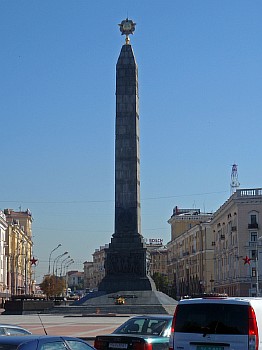
| Science Culture Cooperation Library Multimedia |
|
Main - - Culture - Architectural monuments - Minsk region Victory Square ensemble in Minsk
Victory Square in Minsk (until 1954 it was Round Square). The ensemble of Victory Square started to form in 1939 in accordance with the general plan of Minsk of 1932-1936 (architect Yu.Kilovatov, consultant B. Witman) with the erection of two houses, arc-shaped in plan, on the draft of R. Stoller. In the plastic solution of the facades of the houses with central concave sections, built on the rhythm of double loggias and window openings with a laconic use of the order elements in the frame, is dominated by the classicism features. The development of the square was continued in the post-war years (general plan of 1946, architects M. Androsov, N. Trachtenberg; detailed project of planning and development of 1950, architects M. Barshch, L. and G. Aranauskas; adjustment in 1954, architects G. Zaborskij, L. Matskevich). In accordance with the general plan of 1946 the square had a round shape. The solution of symmetrically placed groups of residential buildings (architect M. Barshch, L. and G. Aranauskas, 1951-1956) is subjected to the urban development of the avenue disclosing the idea of open space perspective, formed by the river Svisloch. The free interpretation of the classical architectural themes is realized in an ensemble arrangement, which is accentuated by plastic and semantic role of inputs to the yards, the monumental two-row colonnades -propylaea of the Doric order. The rhythm of the divisions of the upper tier is built on the alternation of triple windows with columns, balconies, decorated with stucco decor withthe use of plant motifs, vases, garlands, majolica medallions depicting doves. Corners are marked with tower volumes. The compositional dominant of the square is the Victory Monument, established in 1954 (architects H. Zaborski, V.Korol, sculptors Z. Azgur, A. Bembel, A. Glebov, S. Selikhanov) and completing the implementation of the urban concept of the grand architectural and artistic Ensemble. In the solution of the monument classical monumental obelisk form, narrative reliefs illustrating the theme, heraldic elements have been organically synthesized. The side of the square, facing the river, is completed by the Museum of the I Party Congress, the monumental gate - the entrance to Gorky park (architect G. Zaborskij, 1953). In 1984 in connection with the construction of the underground the square was renovated, resulting in an extended configuration and receivingtwo-level plan (architects B. Larchenko, B. Shkolnikov, K. Vyazgin). Under the ground a gallery is connected with the subway station and a hall of memory.
© National Academy of Sciences of Belarus, 2011
|

